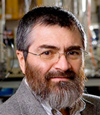Difference between revisions of "New trends in chromatography"
m (→Confirmed speakers: fmt) |
(Add sponsor more later) |
||
| Line 3: | Line 3: | ||
Chromatography has enjoyed over a century of development, culminating in Martin and Synge's award of the Nobel Prize in 1952. The fast development of liquid chromatographic techniques starting in the early 1970s has made HPLC the workhorse of analysis in various fields, such as biomedical, chemical, environmental and pharmaceutical research and development. Although a mature technology (mostly in theoretical aspects), unrelenting needs for ever more efficient and faster analysis have led to significant new developments in chromatography in recent years, notably ultra-high performance liquid chromatography (UPLC), monolithic columns and hydrophilic interaction chromatography (HILIC). UPLC has rapidly grown out of its infancy and moved into the analytical | Chromatography has enjoyed over a century of development, culminating in Martin and Synge's award of the Nobel Prize in 1952. The fast development of liquid chromatographic techniques starting in the early 1970s has made HPLC the workhorse of analysis in various fields, such as biomedical, chemical, environmental and pharmaceutical research and development. Although a mature technology (mostly in theoretical aspects), unrelenting needs for ever more efficient and faster analysis have led to significant new developments in chromatography in recent years, notably ultra-high performance liquid chromatography (UPLC), monolithic columns and hydrophilic interaction chromatography (HILIC). UPLC has rapidly grown out of its infancy and moved into the analytical | ||
labs. The potential and application of UPLC for fast separation will be discussed in this session. Monolithic columns also hold great potential for very fast separations. The discussion will focus on the fabrication and application of newer monolithic columns. Finally, HILIC is being re-evaluated for its unique ability to retain polar compounds. The discussion on HILIC will focus on various HILIC phases and its application in biomedical and pharmaceutical fields. | labs. The potential and application of UPLC for fast separation will be discussed in this session. Monolithic columns also hold great potential for very fast separations. The discussion will focus on the fabrication and application of newer monolithic columns. Finally, HILIC is being re-evaluated for its unique ability to retain polar compounds. The discussion on HILIC will focus on various HILIC phases and its application in biomedical and pharmaceutical fields. | ||
| + | |||
| + | ==Sponsor== | ||
| + | This session is sponsored by '''Thermo Fisher.''' | ||
==Session organizer== | ==Session organizer== | ||
Revision as of 15:18, 18 May 2010
Chromatography has enjoyed over a century of development, culminating in Martin and Synge's award of the Nobel Prize in 1952. The fast development of liquid chromatographic techniques starting in the early 1970s has made HPLC the workhorse of analysis in various fields, such as biomedical, chemical, environmental and pharmaceutical research and development. Although a mature technology (mostly in theoretical aspects), unrelenting needs for ever more efficient and faster analysis have led to significant new developments in chromatography in recent years, notably ultra-high performance liquid chromatography (UPLC), monolithic columns and hydrophilic interaction chromatography (HILIC). UPLC has rapidly grown out of its infancy and moved into the analytical labs. The potential and application of UPLC for fast separation will be discussed in this session. Monolithic columns also hold great potential for very fast separations. The discussion will focus on the fabrication and application of newer monolithic columns. Finally, HILIC is being re-evaluated for its unique ability to retain polar compounds. The discussion on HILIC will focus on various HILIC phases and its application in biomedical and pharmaceutical fields.
Sponsor
This session is sponsored by Thermo Fisher.
Session organizer
Dr. Yong Guo is currently Principal Scientist and team leader at Johnson & Johnson Pharmaceutical Research and Development based in Raritan, New Jersey. Dr. Guo received his Ph. D in analytical Chemistry from State University of New York at Buffalo, and completed his postdoctoral training at Institute of Biotechnology, National Research Council of Canada, Montreal. Dr. Guo is also an adjunct professor of Pharmaceutical Chemistry at Fairleigh Dickinson University, Madison NJ. His research interest is in peak capacity in gradient elution, UPLC and HILIC.
Dr. Guo will speak on "Polar Stationary Phases in Hydrophilic Interaction Chromatography: Retention and Selectivity".
Confirmed speakers
- Prof. Luis A. Colón, Department of Chemistry, State University of New York at Buffalo: "New approaches to monolithic columns for HPLC".
Prof. Colon's research interests include: micro/nano-chemical analysis, capillary electrophoresis and electrochromatography, liquid chromatography, chromatographic stationary phases/materials, bioanalytical chemistry, drug analysis in biological fluids.


